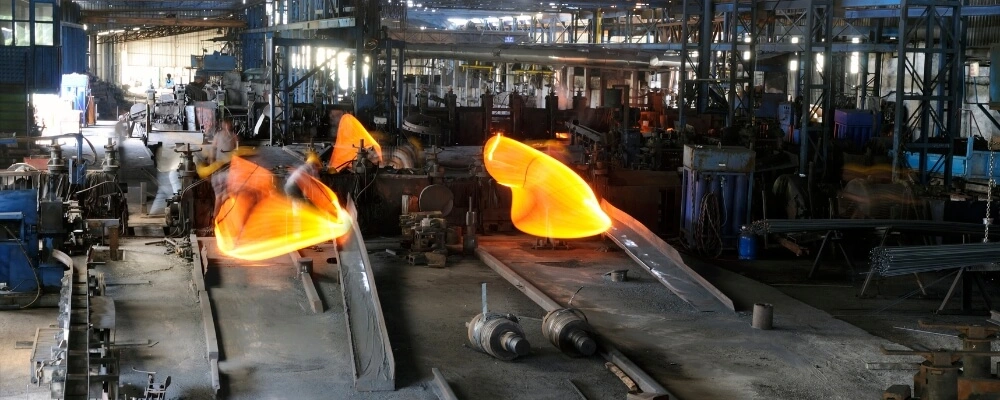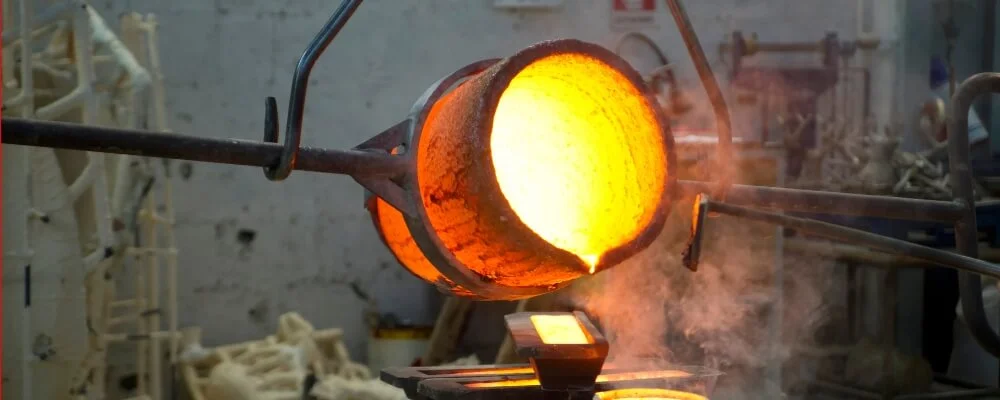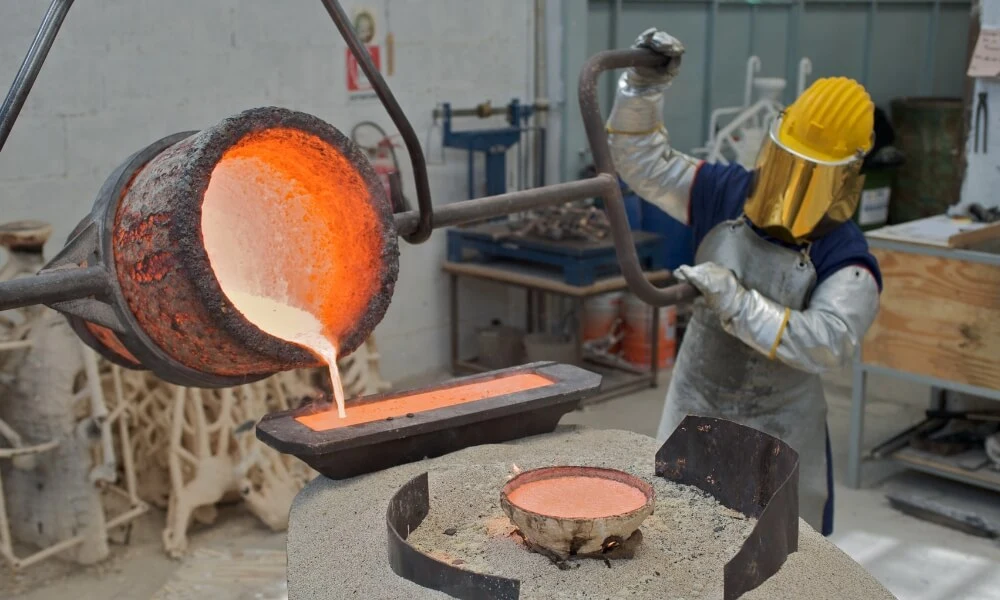Foundry work is inherently hazardous, with workers being exposed to a myriad of risks, including extreme heat, harmful chemicals, loud noises, and heavy machinery. The environment in foundries is laden with potential health risks such as respiratory problems, hearing loss, skin disorders, and even severe conditions like cancer.
The nature of the tasks performed in foundries, such as melting and casting metal, handling hazardous materials, and operating heavy machinery, necessitates stringent safety measures to protect the workers from the diverse range of occupational hazards they encounter daily.
To address these challenges and create a safer working environment, it is imperative to implement and adhere to robust safety rules and utilize appropriate safety equipment. This blog will delve into the various health risks associated with foundry work, explore the top 10 safety rules every foundry worker should follow, and discuss the different types of safety equipment used in foundries.
By understanding and addressing the risks, foundries can foster a safety-conscious culture, ensuring the well-being of their workers and promoting a more productive and harmonious workplace.

Health Risks to Foundry Workers
Foundry workers are exposed to various health risks due to the nature of their work environment and the materials they handle. Here are several health risks associated with working in foundries:
- Respiratory Problems: Inhalation of dust, fumes, and gases can lead to respiratory issues such as asthma, bronchitis, and silicosis. Long-term exposure to respiratory irritants can also contribute to the development of chronic obstructive pulmonary disease (COPD) and lung cancer.
- Hearing Loss: Constant exposure to high levels of noise in foundries can lead to noise-induced hearing loss, a condition that can be permanent and debilitating.
- Heat Stress: Working near molten metal and furnaces can expose workers to extreme heat, leading to heat stress, heat exhaustion, and, in severe cases, heat stroke, which can be fatal.
- Skin Disorders: Contact with harmful chemicals, irritants, and extreme heat can cause various skin disorders, including burns, dermatitis, and skin cancer.
- Musculoskeletal Disorders: Repetitive motions, awkward postures, and manual handling of heavy objects can lead to musculoskeletal disorders such as strains, sprains, and chronic conditions like carpal tunnel syndrome.
- Chemical Exposure: Exposure to hazardous chemicals used in foundry processes can lead to a range of health issues, including chemical burns, poisoning, and systemic toxicity affecting multiple organs.
- Metal Fume Fever: Inhalation of metal oxides, particularly zinc, and copper, can lead to metal fume fever, characterized by flu-like symptoms such as fever, chills, nausea, and muscle aches.
- Vibration Syndrome: Prolonged use of vibrating tools can lead to hand-arm vibration syndrome (HAVS), affecting blood vessels, nerves, joints, and muscles of the hand, wrist, and arm.
- Eye Injuries: Exposure to flying debris, splashes of molten metal, and intense light can cause eye injuries, including burns, cuts, and damage to the retina, potentially leading to vision loss.
- Cancer: Long-term exposure to carcinogenic substances such as silica dust, asbestos, and certain chemicals can increase the risk of developing various types of cancer, including lung, skin, and bladder cancer.
- Psychological Stress: The demanding and hazardous nature of foundry work can lead to psychological stress, potentially resulting in mental health conditions like anxiety and depression.
- Infectious Diseases: Exposure to biological agents, such as bacteria and fungi, can lead to infectious diseases, especially in foundries with poor sanitation and hygiene practices.

10 Foundry Safety Rules Every Worker Should Follow
Here are the top 10 foundry safety rules that every worker should follow to ensure a safe working environment:
1. Wear Appropriate Personal Protective Equipment (PPE)
Wearing the correct Personal Protective Equipment is crucial in a foundry environment. This includes safety gloves, glasses, shoes, and heat-resistant clothing, which are essential to protect workers from molten metal splashes, dust, noise, and other potential hazards.
These items serve as the first line of defense against various risks that foundry workers face daily, ensuring their safety and well-being while performing their tasks.
2. Follow Lockout/Tagout Procedures
Adhering to lockout/tagout procedures is vital to ensure that all machinery is properly shut down and secured during maintenance or repair. This prevents the accidental activation of equipment, protecting workers from unexpected energization or release of stored energy, which can lead to severe injuries or fatalities.
3. Use Respiratory Protection
Given the presence of harmful dust, fumes, and gases in foundries, using appropriate respiratory protection is essential. Respirators help filter out harmful particles and gases, preventing them from being inhaled and causing respiratory problems or other serious health conditions. This is especially important in areas where ventilation may not be sufficient to reduce exposure to acceptable levels.
4. Maintain Proper Ventilation
Working in well-ventilated areas is crucial to minimize exposure to harmful substances. Proper ventilation ensures that harmful particles and gases are expelled from the work area, maintaining air quality and reducing the risk of respiratory diseases. It is also important to ensure that exhaust systems are functioning properly to effectively remove contaminants from the air.
5. Handle Materials Safely
Using proper lifting techniques and equipment is essential when handling materials in a foundry. This helps in avoiding manual handling of heavy objects, reducing the risk of musculoskeletal injuries. Proper material handling also prevents strains, sprains, and other injuries that can occur due to improper lifting or carrying of heavy loads.
6. Avoid Noise Exposure
Foundries are typically noisy environments, and prolonged exposure to high noise levels can lead to hearing loss. Using ear protection such as earplugs or earmuffs helps in reducing noise exposure. It is also important to limit the time spent in noisy environments and to have regular hearing checks to monitor any changes in hearing ability.
7. Practice Good Housekeeping
Maintaining cleanliness and order in work areas is essential to prevent tripping hazards and other accidents. Good housekeeping practices include keeping walkways clear, properly storing tools and materials, and removing clutter. Ensuring that emergency exits are clear is also crucial to allow for quick evacuation in case of an emergency.
8. Follow Emergency Procedures
Being familiar with and following emergency procedures is critical for safety in foundries. Workers should know the location of emergency exits, fire extinguishers, and first aid kits. They should also be trained in emergency evacuation procedures to ensure a swift and orderly exit from the premises in the event of an emergency.
9. Stay Informed and Trained
Regular participation in safety training is crucial for staying informed about the hazards and safety procedures related to specific tasks in a foundry. Being knowledgeable about potential risks and the correct safety measures to take helps in preventing accidents and injuries. Training also fosters a safety-conscious work culture, where everyone is aware of their responsibilities in maintaining a safe working environment.
10. Report Unsafe Conditions
Reporting any unsafe conditions, near misses, or accidents immediately is essential for maintaining a safe work environment. Prompt reporting allows supervisors to address and rectify unsafe conditions quickly, preventing further incidents. It also contributes to the continuous improvement of safety practices, helping to create a safer and more secure workplace for everyone.

Different Foundry Safety Equipment
Foundry safety equipment is crucial to protect workers from the various hazards present in foundry environments. Here are the different types of safety equipment used in foundries:
1. Personal Protective Equipment (PPE)
- Safety Gloves: Protect hands from burns, cuts, and chemical exposure.
- Safety Glasses: Shield eyes from splashes, dust, and debris.
- Safety Shoes: Protect feet from falling objects and molten metal splashes.
- Heat-Resistant Clothing: Guards against burns from molten metal and high temperatures.
- Respirators: Filter harmful dust, fumes, and gases to prevent inhalation.
- Ear Protection: Reduces noise exposure to prevent hearing loss.
- Safety Helmets: Protect the head from impact and falling objects.
2. Ventilation and Exhaust Systems
- These systems ensure proper air circulation and remove harmful substances from the air, maintaining a safe breathing environment.
3. Gas Detectors and Analyzers
- These devices detect the presence of harmful gases and vapors in the air, allowing for immediate action to be taken.
4. Fire Extinguishers and Fire Safety Equipment
- Essential for controlling and extinguishing fires, preventing their spread, and minimizing damage.
5. First Aid Kits
- Provide immediate medical attention for minor injuries and are crucial in emergency situations.
6. Emergency Showers and Eye Wash Stations
- Offer immediate decontamination and eye flushing in case of chemical exposure.
7. Fall Protection Equipment
- Includes harnesses and lanyards to protect workers from falls in elevated areas.
8. Noise Control Equipment
- Such as sound barriers and earmuffs, help in reducing noise levels and protecting workers’ hearing.
9. Air Pollution Control Equipment
- Helps in controlling the emission of pollutants, protecting both workers and the environment.
10. Hazardous Waste Recycling and Treatment Equipment
- Manages and treats hazardous waste produced in foundries, minimizing environmental impact.
11. Radioactive Detection and Handling Equipment
- Detects and handles radioactive materials, preventing exposure and contamination.
12. Water Pollution Control and Treatment Equipment
- Treats water pollutants and ensures the release of clean water, protecting aquatic ecosystems.
13. Safety Shields and Barriers
- Provide protection against splashes, sparks, and flying debris during foundry operations.
14. Manual Handling Equipment
- Such as hoists and conveyors, assist in the safe handling and movement of materials.
15. Environmental Control Equipment
- Monitors and controls environmental conditions, ensuring a safe and healthy workplace.
16. Safety Signs and Labels
- Communicate important safety information and instructions clearly and effectively.
Each piece of equipment plays a vital role in maintaining the safety and well-being of foundry workers and protecting the environment from the adverse impacts of foundry operations. Regular inspection and maintenance of this equipment are also crucial to ensure its effectiveness and reliability.
Conclusion
In conclusion, the foundry industry, characterized by its intense and hazardous working conditions, necessitates stringent safety protocols and the use of specialized safety equipment to mitigate the myriad of health risks faced by foundry workers. The implementation of robust safety rules is paramount in fostering a culture of safety and awareness, which is crucial in minimizing incidents and protecting workers from the potential dangers inherent in foundry processes.
By understanding the diverse range of health risks, from respiratory problems to the risk of cancer, and by adhering to established safety rules and utilizing appropriate safety equipment, workers and employers alike can contribute to creating a safer, healthier, and more productive working environment.
The commitment to safety and health in foundries is not just a regulatory requirement but a moral obligation to ensure the well-being and longevity of every individual in the industry.

